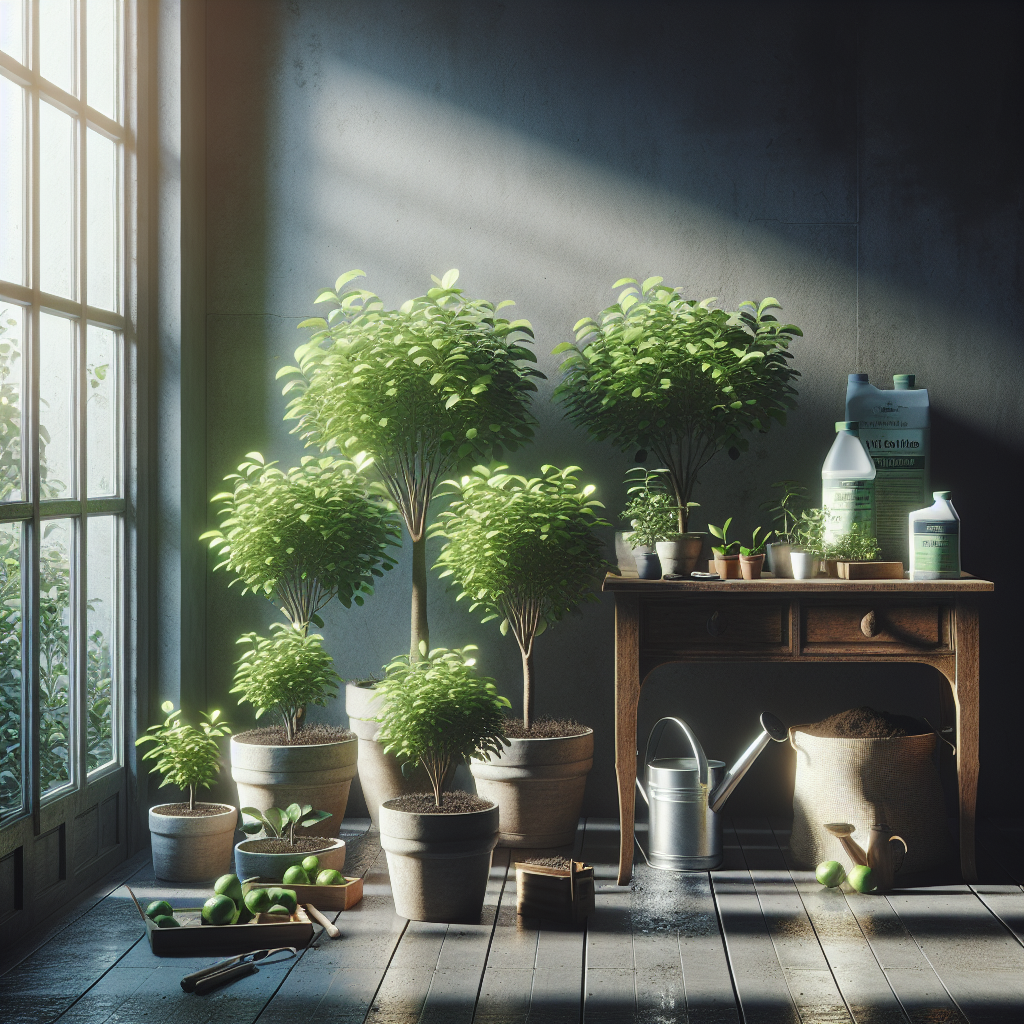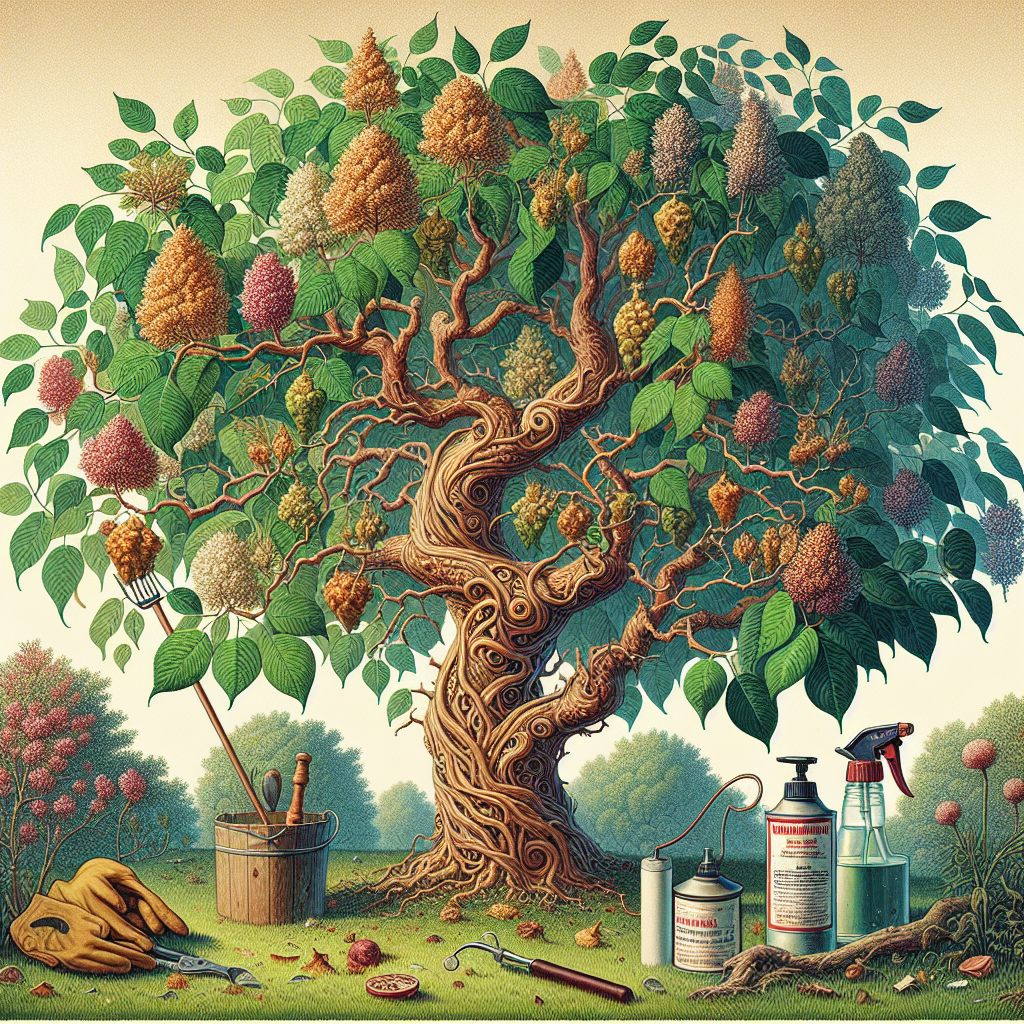The Secrets to Growing a Healthy Indoor Lime Tree
Updated May 15, 2024 at 6:59 am

Overview of Growing a Healthy Indoor Lime Tree
-
Pet Friendly
Lime trees are non-toxic and generally considered safe for pets. They might not enjoy the citric taste though, so it is best to keep the tree out of their reach.
Light Requirements
Indoor lime trees thrive in full, bright light. A south-facing window where they can get at least 6 to 8 hours of sunlight is ideal.
Watering
Watering should be done when the top inch of soil feels dry to the touch. Overwatering can lead to root rot, so ensure proper drainage.
Humidity
Lime trees enjoy moderate to high humidity. Regular misting or a humidifier can help to replicate their natural environment.
Temperature
These trees prefer a temperature range of 65-85°F (18-29°C) and should be protected from cold drafts and extreme temperature changes.
Difficulty
Growing a healthy indoor lime tree is a moderate challenge but incredibly rewarding with the right care and tips.
Choosing the Right Indoor Lime Tree Variety
When it comes to indoor lime trees, not all varieties are created equal. Some of the most popular ones that adapt well to indoor conditions include the Dwarf Persian Lime, Kaffir Lime, and the Key Lime. The Dwarf varieties, in particular, are a fantastic choice for indoor gardening, as they can be maintained at a manageable size with regular pruning.
Securing the Perfect Pot and Soil
The right container and soil are critical for the health of your indoor lime tree. The pot should be spacious enough to accommodate growth and have adequate drainage holes. As for soil, a well-draining potting mix is crucial. Citrus trees do not like “wet feet,” so a mix designed specifically for citrus or cacti can often provide the drainage needed. An excellent product to consider is the FoxFarm Ocean Forest Potting Soil, which is pH-adjusted and ideal for growing lime trees indoors.
Pros
- It is light and airy, promoting good root structure.
- Contains earthworm castings and bat guano for natural fertilization.
- pH adjusted to allow for optimum fertilizer uptake.
Cons
- May be more expensive than standard potting soil.
- Sometimes too nutrient-rich for young seedlings.
Find This and More on Amazon
Lighting Needs for Your Indoor Lime Tree
Light is a make-or-break factor in the health of your indoor lime tree. These trees are solar-powered, and without an abundance of light, they won’t produce the fruit you’re hoping for. If your home doesn’t get enough natural light, don’t fret—it might be worth investing in a high-quality grow light. Products like the VIPARSPECTRA LED Grow Light have been well-received by indoor gardeners. These lights can provide a full spectrum for all stages of growth, simulating natural sunlight.
Pros
- Full spectrum LEDs mimic natural sunlight.
- Energy efficient compared to traditional growing lights.
- Comes with adjustable hangers for variable heights.
Cons
- Can be a significant initial investment.
- May produce excess heat if not managed properly.
Watering: Striking the Right Balance
Maintaining the delicate balance of watering your indoor lime tree is perhaps one of the trickiest aspects for many gardeners. Both under-watering and over-watering pose significant threats to the tree’s well-being. A useful tool for beginners and seasoned gardeners alike is a moisture meter, such as the XLUX Soil Moisture Meter. This device helps take the guesswork out of watering by telling you exactly when your plant needs a drink.
Pros
- No batteries or electricity required.
- Easy to read moisture levels instantly.
- Helps prevent over-watering and under-watering.
Cons
- Can be fragile if not used carefully.
- Must be inserted correctly for an accurate reading.
Fertilizing: Essential Nutrients for Growth
Lime trees are heavy feeders and require regular fertilizing to produce lush foliage and healthy fruits. A balanced, slow-release fertilizer formulated for citrus trees will ensure your lime tree gets all the essential nutrients over time. One standout product is the Jobe’s Organics Fruit & Citrus Fertilizer with Biozome, which is an organic, granular fertilizer that is gentle on plants and provides a mix of important nutrients.
Pros
- OMRI listed for organic gardening.
- Improves soil conditions and helps resist disease.
- Contains Jobe’s Biozome to enhance nutrient availability.
Cons
- May need to be reapplied more frequently than chemical fertilizers.
- Organic fertilizers generally work slower than synthetic ones.
Pruning and Maintenance for a Thriving Lime Tree
Just like any other indoor plant, lime trees require regular pruning to maintain shape and encourage growth. When you prune, you’re not only shaping the tree but also allowing light to reach the inner leaves, which is crucial for the tree’s overall health. Pruning can seem daunting, but with a quality pair of pruning shears, like the Fiskars Steel Pruning Shears, even a beginner can successfully maintain their tree. With an ergonomic design and a precision-ground steel blade, these shears make clean cuts for healthy growth.
Pros
- Ergonomic handles provide a comfortable grip.
- Self-cleaning sap groove keeps the blades from sticking.
- Easy-open lock protects the blade during transport and storage.
Cons
- Blades may need sharpening with heavy use over time.
- Not ideal for very thick branches or hardwood.
Dealing with Pests and Diseases
Pest infestations and diseases are common problems that can afflict indoor lime trees. Aphids, spider mites, and scale insects can quickly become a nuisance. Using an eco-friendly insecticide like the Neem Bliss 100% Pure Cold Pressed Neem Seed Oil offers a natural solution to such problems. It’s a potent and safe-to-use product that can protect your lime tree without the use of harsh chemicals.
Pros
- Acts as both a pest repellent and a fungicide.
- Safe for use around pets and children when used as directed.
- Can be used as a leaf shine to keep foliage looking lush.
Cons
- Strong scent that some may find unpleasant.
- Needs to be emulsified before application, which requires additional steps.
Repotting Your Lime Tree for Optimal Health
As your lime tree grows, it will eventually need to be repotted to provide extra space for its roots to expand. Generally, this is done every few years, but you should always be on the lookout for roots growing through the drainage holes — a sure sign that it’s time for a bigger home. When repotting, it’s crucial to be gentle and use a fresh potting mix to reduce transplant stress. Consider containers like the Bloem Terra Pot Planter, which comes with excellent drainage and is made from durable, high-quality plastic.
Pros
- Comes in various sizes to accommodate growing plants.
- Sturdy and designed to withstand the elements, even when placed outside during warmer months.
- Classic design that fits well with most home decor.
Cons
- Plastic may not be as breathable as terracotta or fabric pots.
- Some gardeners prefer more natural materials for their planters.
Cold Protection: Keeping Your Lime Tree Warm
While indoor lime trees are protected from frost, they still need to be sheltered from cold drafts and sudden temperature drops, particularly during winter months. To help protect your lime tree, consider investing in a quality plant heat mat, such as the VIVOSUN Waterproof Seedling Heat Mat. This can be especially useful for providing a constant heat source during those colder days.
Pros
- Provides consistent and even heat for plant roots.
- Waterproof construction ensures safety and durability.
- Compatible with thermostats for precise temperature control.
Cons
- Can increase your electricity bill if used extensively.
- Not necessary for all climates, so may not be a worthy investment for some.
Harvesting Your Limes: When and How
The fruits of your labor — quite literally! When it comes to harvesting limes from your indoor tree, timing is everything. You want to pluck them from the branch when they are fully grown but before they become overripe. A good way to determine ripeness is by the color and slight give when you squeeze them. Limes are typically ready to harvest when they turn slightly yellowish or light green and have a slight give under gentle pressure. Enjoying the fresh limes from your own grown tree is one of the most satisfying experiences for any indoor gardener.
Enjoying the Journey of Indoor Gardening
Remember, the process of growing and nurturing a healthy indoor lime tree can be just as rewarding as the end results. Enjoy the journey: from selecting the right variety, to watching the tree flourish under your care. Along the way, you’ll learn what works best for your environment and develop a deeper connection with your homegrown citrus friend. So, take a deep breath, be patient, and relish the fresh zest of your very own limes!
Common Issues and Solutions for Indoor Lime Trees
Growing an indoor lime tree can come with its set of challenges. You might notice the leaves turning yellow or dropping, which could be a sign of various issues such as nutrient deficiencies, overwatering, or lack of proper lighting. Its important to observe your plant closely and address problems as they arise. For example, yellow leaves may indicate a need for more iron or magnesium. In such cases, a chelated iron supplement can be beneficial. Based on reviews, the Southern Ag Chelated Liquid Iron is favored by many plant enthusiasts for its efficacy in correcting yellowing leaves. Reviewers appreciate that it’s easy to administer and see improvements in their plants after application. However, some mention that it’s crucial to follow directions closely to prevent root burn.
Pros
- Effectively treats iron deficiency in plants leading to greener leaves.
- Liquid form makes it easy to mix and apply with watering.
- Works quickly to improve plant health.
Cons
- Can cause harm to the plant if overused or not diluted properly.
- Has the potential to stain surfaces if spilled.
The Joy of Fragrance and Flowering
Indoor lime trees are known not only for their tart edible fruits but also for their pleasantly fragrant flowers, which can add a delightful scent to your home. Enjoying these delicate white blossoms is another compelling reason to venture into growing lime trees indoors. To enhance flowering, consider using a high-phosphorus fertilizer to boost bloom production. A product like Jack’s Classic Blossom Booster Fertilizer has a high phosphorus content and is revered among gardeners for encouraging blooms on flowering plants. According to gardeners who have used this product, it has helped increase the number and quality of their indoor lime tree flowers significantly, leading to more fruit production. Again, the advice is to adhere to the recommended dosage to prevent fertilizer burn.
Pros
- Formulated specifically to increase blooms.
- Water-soluble and easy to use during regular watering routines.
- Here’s the value proposition: a little product goes a long way.
Cons
- Must be used carefully according to the instructions to prevent overfeeding.
- Not all-purpose; specifically for flowering and fruiting results.
Final Tips for a Flourishing Indoor Lime Tree
In order to ensure you get the most out of your indoor lime tree, remember these final nuggets of wisdom. Consistency in care is key—from watering to fertilizing, every little bit contributes to the overall health of your tree. Monitor for any signs of stress and respond accordingly. Rotate your tree regularly to ensure all sides receive an equal amount of light, particularly if it’s placed near a window. Also, be observant of the humidity levels, as dry air can hamper growth. Consider investing in a humidity tray or grouping your lime tree with other plants to create a microclimate with higher humidity. Finally, embrace the experience. You’re not only growing a tree; you’re cultivating patience, knowledge, and a wonderful sense of accomplishment. May your indoor lime tree bring you an abundance of zest, both in spirit and in flavor!
Encouragement for Aspiring Indoor Gardeners
If you’re thinking about starting your own indoor lime tree, or any indoor garden, go for it! Like any new endeavor, there will be learning curves, but the rewards are plentiful. You’ll have the opportunity to grow fresh produce, brighten your living space, and even improve your mental well-being. Connect with a community of fellow gardeners, either locally or online, to share tips and experiences. Plant care can become an enriching hobby that adds beauty and vibrancy to your life. And remember, every expert was once a beginner, so begin your journey with excitement and watch as your green thumb develops over time. Happy gardening!
Shop more on Amazon

